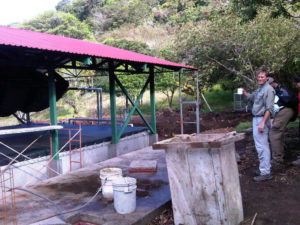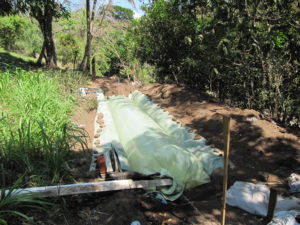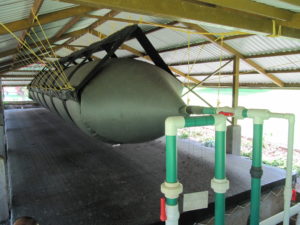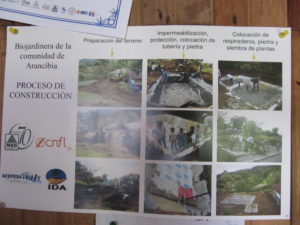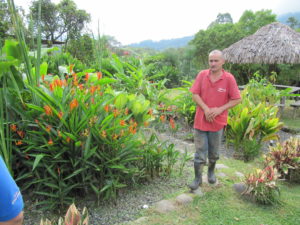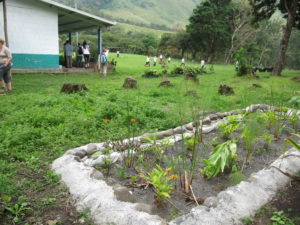ANAEROBIC DIGESTORS
Lack of wastewater treatment can create a plethora of human health problems and result in substantial environmental degradation. Runoff from agricultural activity is a major contributor to water quality degradation, as feces and urine from animals can heavily damage water quality, and may carry disease-causing agents. Polluted or damaged water sources may carry diseases which can cause headache, vomiting, diarrhea, fever, and parasites, the latter of which are a common problem associated with water contaminated by animal wastes.
It is environmentally beneficial to mitigate methane emissions by use of anaerobic biodigesters. Following CO2, which accounted for 80.9% of U.S GHG in 2014, methane (CH4) is the second most prevalent greenhouse gas emitted from human activities (EPA 2014). Methane emissions are a cause of great concern in climate change mitigation because the gas is twenty-five times more concentrated than carbon dioxide (Scholtz et al. 2014). “Methane is emitted by natural sources such as wetlands, as well as human activities such as leakage from natural gas systems and the raising of livestock. Methane’s lifetime in the atmosphere is much shorter than carbon dioxide (CO2), but CH4 is more efficient at trapping radiation than CO2. Pound for pound, the comparative impact of CH4 on climate change is more than 25 times greater than CO2 over a 100-year period.” Evidence suggests that the comparative global warming impact of methane is even greater than 25 times that of CO2 in the short run, i.e. less than 100 years (EPA 2014).
After spending several years learning about the technology from EARTH University, in February 2011, UGA Costa Rica constructed the first anaerobic digester in the Monteverde region with the goal of studying the effectiveness of this wastewater treatment technology in the high elevations and cool climate of Monteverde. The design and scale approximated the scale that would be relevant for a small farm household in the San Luis de Monteverde region, treating the daily waste produced by four-to-six pigs and two-to-three milk cows. There was question about whether this system would work in a cool climate such as the cloud forest. Within one year, the results proved very positive, with production of up to 4m3 of biogas per day. The success of this unit led to two important developments — the donation of funds to install similar biodigester systems for 10 local farms, and the construction of an industrial scale anaerobic digestion wastewater treatment plant for the UGA Costa Rica campus to replace the primary septic system servicing the public restrooms and dormitories.
In 2012 – 2013, UGA Costa Rica collaborated with the Monteverde Institute, and student groups from both organizations helped to install a total of 14 biodigesters at neighboring farms as service-learning activities on their study abroad programs. In early 2013, UGA Costa Rica completed construction and began using the region’s largest anaerobic wastewater treatment facility. A team of graduate students in Landscape Architecture then developed educational signage for the system, which facilitates learning about how the system functions. In September 2013, this system was connected to the UGA Costa Rica campus kitchen, providing gas for cooking meals served in the campus dining hall. In 2016, a third small-scale biodigester was installed parallel to the initial system, and the number of pigs kept at the UGA Costa Rica campus was doubled. Both of the smaller systems were also connected to the campus’ kitchen with the gas used for cooking and keeping food warm in the buffet line.
The UGA Costa Rica campus’ biodigesters, small and large, have become important tools for disseminating information about how anaerobic digesters work. The ability to tour these facilities and observe first-hand has stimulated interest in local farmers as well as in a wide variety of business operations as a means to effectively and affordably treat wastewater, generate alternative energy, and reduce overall carbon emissions. In addition to local farmers and business owners, thousands of students, faculty, administrators, and tourists from around the world have toured the UGA Costa Rica facilities to learn about the process and many benefits of anaerobic digestion as a means of wastewater treatment, including the reduction of greenhouse gas emissions. These biodigesters have also stimulated a growing research program from a variety of disciplinary foci, including using effluent and sludge to make enhanced compost which can substitute synthetic fertilizers, providing cost savings and minimizing negative environmental impacts, including greenhouse gas emissions, related to synthetic fertilizer use.
Biodigester effluent is an excellent material for compost, and more methodical management of livestock waste can reduce stream pollution. The fertilizer value of many wastewaters is likewise important. “FAO (1992) estimated that typical wastewater effluent from domestic sources could supply all of the nitrogen and much of the phosphorus and potassium that are normally required for agricultural crop production. In addition, micronutrients and organic matter also provide additional benefits” (FAO 1997). Biogas digesters generate energy for consumption, reduce agricultural environmental damages, minimize GHG emissions, provide high quality compost materials, and diminish animal waste management concerns. Farmers are seeing the economic opportunities biodigesters can provide. Not only do biodigesters function to protect ecosystem health, but they reduce the need to purchase fuel for cooking and aid in more sustainable farming practices while incorporating livestock.
In addition to biodigesters, there are opportunities to treat wastewater through the installation of biogardens. These, in tandem with biodigesters, make an important contribution to reducing contamination from wastewater runoff. When combined with agro-forestry, they represent a holistic approach to sustainable farm management.
ALAP is seeking university partners to develop biogas offset projects in both of our project regions.


